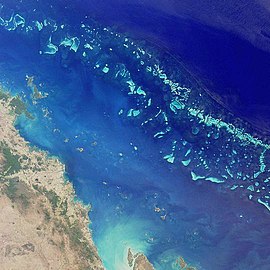Loading AI tools
National heritage register of Australia From Wikipedia, the free encyclopedia
The Australian National Heritage List or National Heritage List (NHL) is a heritage register, a list of national heritage places deemed to be of outstanding heritage significance to Australia, established in 2003. The list includes natural and historic places, including those of cultural significance to Indigenous Australians such as Aboriginal Australian sacred sites. Having been assessed against a set list of criteria, once a place is put on the National Heritage List, the provisions of the Environment Protection and Biodiversity Conservation Act 1999 (EPBC Act) apply.
 Satellite image of part of the Great Barrier Reef adjacent to the Queensland coastal areas of Airlie Beach and Mackay. | |
| Type | Heritage register of natural, historic and indigenous places that are not owned by the Commonwealth of Australia |
|---|---|
| Country | Australia |
| Years | 2003–present |
| Preceded by | Register of the National Estate |
| Compiled by | Commonwealth of Australia via the Australian Heritage Council |
| Approved by | Minister for the Environment |
All places on this list can be found on the online Australian Heritage Database, along with other places on other Australian and world heritage listings.
The National Heritage List was established in 2003 by an amendment to the Environment Protection and Biodiversity Conservation Act 1999.[1]
The National Heritage List, together with the Commonwealth Heritage List, replaced the former Register of the National Estate, which was closed and archived in 2007. Places on the National Heritage List are places of outstanding heritage value for Australia, while the Commonwealth Heritage List are heritage places that are owned or controlled by the Commonwealth of Australia.[2][3]
The National Heritage List is a list of places deemed to be of outstanding heritage significance to Australia.[4] Once on the list, the provisions of the EPBC Act apply.[5] To be included on the list, a nominated place is assessed by the Australian Heritage Council against nine criteria:[6]
In addition, the place must pass a "significance threshold"; it must have 'outstanding' heritage value to the nation as a whole. This is determined by comparison to other similar places. Once the Heritage Council has made an assessment, it forwards a recommendation to the Minister for the Environment, who shall make a determination.[6]
As of 10 August 2020[update], the Australian National Heritage List comprised 120 heritage places as follows:[7]
| State/territory | Number of places |
|---|---|
| Australian Capital Territory | 5 |
| New South Wales | 36 |
| Northern Territory | 4 |
| Queensland | 13 |
| South Australia | 8 |
| Tasmania | 11 |
| Victoria | 32 |
| Western Australia | 15 |
| Other territories | 3 |
| (duplicates): | (4)[lower-alpha 1] |
| Total: | 120 |
The Australian National Heritage List comprises these sites:
Seamless Wikipedia browsing. On steroids.
Every time you click a link to Wikipedia, Wiktionary or Wikiquote in your browser's search results, it will show the modern Wikiwand interface.
Wikiwand extension is a five stars, simple, with minimum permission required to keep your browsing private, safe and transparent.